Ariel Gordon's Blog, page 58
September 23, 2012
Picking at LEAST a peck of pears
Here are a few pictures from my second-to-last Fruit Share pick.
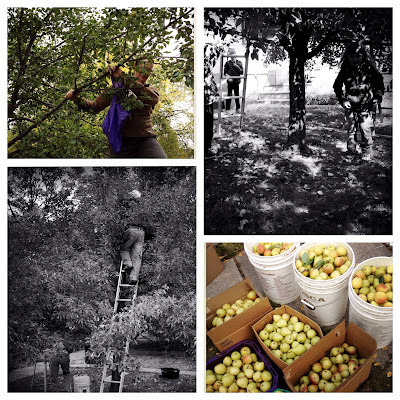 These were St. Vital pears. Small handfuls / small green dreams.
These were St. Vital pears. Small handfuls / small green dreams.
And we picked everything but the topmost branches bare in about an hour, which we estimated was approximately 130 pounds of fruit.
My favourite part of the pick was weighing the boxes and buckets of pears on an ancient bathroom scale.
Also, the homeowner's makeshift picking tool, which involved a whittled wooden ruler and a plastic bag attached to a long pole.
Also, how the various children brought along by Fruit share volunteers congregated under the tree's branches, avoiding the pears that rocketed down from high branches and giggling.
Luckily, the pears need a week or so to ripen, because I'm still eating/peeling/freezing my way through two boxes of frost-sweetened apples.
 These were St. Vital pears. Small handfuls / small green dreams.
These were St. Vital pears. Small handfuls / small green dreams.And we picked everything but the topmost branches bare in about an hour, which we estimated was approximately 130 pounds of fruit.
My favourite part of the pick was weighing the boxes and buckets of pears on an ancient bathroom scale.
Also, the homeowner's makeshift picking tool, which involved a whittled wooden ruler and a plastic bag attached to a long pole.
Also, how the various children brought along by Fruit share volunteers congregated under the tree's branches, avoiding the pears that rocketed down from high branches and giggling.
Luckily, the pears need a week or so to ripen, because I'm still eating/peeling/freezing my way through two boxes of frost-sweetened apples.
Published on September 23, 2012 10:04
September 22, 2012
Lyon's sequel bit bumpy, but what a ride it is...
Winnipeg Free Press - PRINT EDITION
Reviewed by: Ariel Gordon
The Sweet Girl
By Annabel Lyon
Random House Canada, 236 pages, $30
A sequel to her much-ballyhooed The Golden Mean (2009), B.C. writer Annabel Lyon's The Sweet Girl is also a coming-of-age novel.
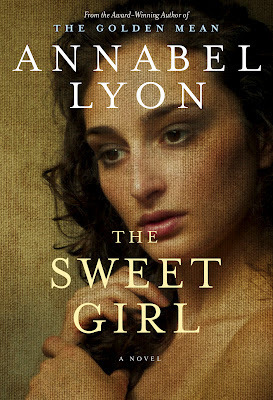 The first explored the prime of the Greek philosopher Aristotle in the fourth century BCE, the second a tumultuous year in the life of his teenage daughter, Pythias.
The first explored the prime of the Greek philosopher Aristotle in the fourth century BCE, the second a tumultuous year in the life of his teenage daughter, Pythias.
The first is about striving for balance, the second, the struggle to survive.
Rest assured, The Sweet Girl - recently longlisted for Canada's Giller Prize - has inherited its predecessor's marvellous ability to wheel between the mind and the body, between thinking and feeling. It is just as canny, just as agonizing, just as alive.
But in The Sweet Girl, gods literally walk the earth. They are not Aristotle's "metaphysical necessity ... remote and oblivious and lost in contemplation," but lurid and powerful realities.
Which, if you're keeping track, makes this both magic realism-tinged fiction and historical fiction.
In addition, where Aristotle's story featured a bipolar polymath forced to learn control, to find focus, Pythias's revolves around class and gender and is steeped in chaos.
Early in the novel, Pythias calls herself "Daddy's Shadow," and it's true, their household revolves around Aristotle's work and his (declining) health.
Pythias is both stubbornly intelligent and much-loved, a combination that allows her to resist the roles assigned to women in ancient Greece while her father is alive.
After he dies and the household disperses, Pythias must somehow step out from behind Aristotle's long shadow, lift her veil, and speak.
This means somehow reconciling her honeyed childhood with the rawness of life as a woman with no money and few choices.
Structurally, the Vancouver-based Lyon, who studied classical music, philosophy and law, has taken a few risks in The Sweet Girl.
The first half of the novel is business as usual, charting Pythias's childhood in Athens and her family's flight to Macedonia after Alexander the Great dies while on campaign in Babylon (what is now Iraq).
The second half is both more and less controlled. The grieving Pythias finds herself unwilling to return to Athens and live in the household of Theophrastos, Aristotle's protégé and successor at the Lyceum.
Theophrastos has opinions about the education of girls, which would mean Pythias's days would be spent at the loom instead of conducting dissections or reading.
So instead Pythias attempts to maintain Aristotle's household while waiting for the man her father wanted her to marry - an older cousin who is a soldier in Alexander's army - to return home.
She fails, of course. She is 16, with no experience running an estate, no allies, and, most important, no money.
And so she becomes an acolyte at a temple of Artemis, the goddess of the hunt and protector of young girls. Disheartened by the avarice of the priestesses, she becomes an apprentice to the local midwife/abortionist and then, briefly, a prostitute.
Pythias has just reconciled herself to the realities of her new life when her prospective husband arrives, battle-scarred and deeply exhausted.
She is lucky. Her fiancé doesn't care about Pythias's sexual history or her bookish pursuits. But like Mary Anning, the 19th-century fossil hunter in Winnipegger Joan Thomas's 2010 novel Curiosity, Pythias will never be able to truly transcend class and gender.
Though The Sweet Girl ultimately succeeds in telling a story that is both the same as and different enough from The Golden Mean, readers might find themselves wondering why Pythias considers prostitution to be a better option than a few months of safe boredom.
Also, the second half of the novel is both exhilarating and a burr under the book's saddle. It is both too formulaic and too bumpy.
But, oh, what a ride!
Ariel Gordon is a Winnipeg writer.
Reviewed by: Ariel Gordon
The Sweet Girl
By Annabel Lyon
Random House Canada, 236 pages, $30
A sequel to her much-ballyhooed The Golden Mean (2009), B.C. writer Annabel Lyon's The Sweet Girl is also a coming-of-age novel.
 The first explored the prime of the Greek philosopher Aristotle in the fourth century BCE, the second a tumultuous year in the life of his teenage daughter, Pythias.
The first explored the prime of the Greek philosopher Aristotle in the fourth century BCE, the second a tumultuous year in the life of his teenage daughter, Pythias.The first is about striving for balance, the second, the struggle to survive.
Rest assured, The Sweet Girl - recently longlisted for Canada's Giller Prize - has inherited its predecessor's marvellous ability to wheel between the mind and the body, between thinking and feeling. It is just as canny, just as agonizing, just as alive.
But in The Sweet Girl, gods literally walk the earth. They are not Aristotle's "metaphysical necessity ... remote and oblivious and lost in contemplation," but lurid and powerful realities.
Which, if you're keeping track, makes this both magic realism-tinged fiction and historical fiction.
In addition, where Aristotle's story featured a bipolar polymath forced to learn control, to find focus, Pythias's revolves around class and gender and is steeped in chaos.
Early in the novel, Pythias calls herself "Daddy's Shadow," and it's true, their household revolves around Aristotle's work and his (declining) health.
Pythias is both stubbornly intelligent and much-loved, a combination that allows her to resist the roles assigned to women in ancient Greece while her father is alive.
After he dies and the household disperses, Pythias must somehow step out from behind Aristotle's long shadow, lift her veil, and speak.
This means somehow reconciling her honeyed childhood with the rawness of life as a woman with no money and few choices.
Structurally, the Vancouver-based Lyon, who studied classical music, philosophy and law, has taken a few risks in The Sweet Girl.
The first half of the novel is business as usual, charting Pythias's childhood in Athens and her family's flight to Macedonia after Alexander the Great dies while on campaign in Babylon (what is now Iraq).
The second half is both more and less controlled. The grieving Pythias finds herself unwilling to return to Athens and live in the household of Theophrastos, Aristotle's protégé and successor at the Lyceum.
Theophrastos has opinions about the education of girls, which would mean Pythias's days would be spent at the loom instead of conducting dissections or reading.
So instead Pythias attempts to maintain Aristotle's household while waiting for the man her father wanted her to marry - an older cousin who is a soldier in Alexander's army - to return home.
She fails, of course. She is 16, with no experience running an estate, no allies, and, most important, no money.
And so she becomes an acolyte at a temple of Artemis, the goddess of the hunt and protector of young girls. Disheartened by the avarice of the priestesses, she becomes an apprentice to the local midwife/abortionist and then, briefly, a prostitute.
Pythias has just reconciled herself to the realities of her new life when her prospective husband arrives, battle-scarred and deeply exhausted.
She is lucky. Her fiancé doesn't care about Pythias's sexual history or her bookish pursuits. But like Mary Anning, the 19th-century fossil hunter in Winnipegger Joan Thomas's 2010 novel Curiosity, Pythias will never be able to truly transcend class and gender.
Though The Sweet Girl ultimately succeeds in telling a story that is both the same as and different enough from The Golden Mean, readers might find themselves wondering why Pythias considers prostitution to be a better option than a few months of safe boredom.
Also, the second half of the novel is both exhilarating and a burr under the book's saddle. It is both too formulaic and too bumpy.
But, oh, what a ride!
Ariel Gordon is a Winnipeg writer.
Published on September 22, 2012 17:21
September 13, 2012
Imagining! Winnipeg!
This is another day-job post. Specifically, about MY day-job, as promotions/editorial assistant at the University of Manitoba Press.
 Like most writers, I have a day-job. Luckily, mine is a part-time day-job. And, if I have to have a day-job at all, I'm pretty content to have it be at UMP, especially as my job description there veers more and more towards multimedia goodness.
Like most writers, I have a day-job. Luckily, mine is a part-time day-job. And, if I have to have a day-job at all, I'm pretty content to have it be at UMP, especially as my job description there veers more and more towards multimedia goodness.
Anyways, yesterday what I persist in calling 'the Foote book' arrived from Friesens, the printer we use in Altona, MB.
I thought I'd share this image of our traditional look-see, where staff stand in a circle in the main office, muttering about details like the spine, the back cover, how the paper looks.
It's the first chance we have, as a staff, to see the culmination of all the steps in the editorial and printing process.
The look-see for Imagining Winnipeg took longer than usual. We had to call in Esyllt W. Jones, the book's author, sand several other UMP authors and SJC faculty happened to drop by just after the book arrived.
I found myself peering at the backgrounds of the images, as details I hadn't seen when working with digital images kept emerging...and I suddenly wanted to find a quiet room and spend hours poring over the photos. Again.
In a word: fun!
* * *
From top right: UMP Managing Editor Glenn Bergen, Sales and Marketing Supervisor Cheryl Miki, author Esyllt W. Jones; UMP author Jim Blanchard (giving me the stink eye), and the hand of former Parks Canada historian (and now SJC fellow) Robert Coutts.
 Like most writers, I have a day-job. Luckily, mine is a part-time day-job. And, if I have to have a day-job at all, I'm pretty content to have it be at UMP, especially as my job description there veers more and more towards multimedia goodness.
Like most writers, I have a day-job. Luckily, mine is a part-time day-job. And, if I have to have a day-job at all, I'm pretty content to have it be at UMP, especially as my job description there veers more and more towards multimedia goodness. Anyways, yesterday what I persist in calling 'the Foote book' arrived from Friesens, the printer we use in Altona, MB.
I thought I'd share this image of our traditional look-see, where staff stand in a circle in the main office, muttering about details like the spine, the back cover, how the paper looks.
It's the first chance we have, as a staff, to see the culmination of all the steps in the editorial and printing process.
The look-see for Imagining Winnipeg took longer than usual. We had to call in Esyllt W. Jones, the book's author, sand several other UMP authors and SJC faculty happened to drop by just after the book arrived.
I found myself peering at the backgrounds of the images, as details I hadn't seen when working with digital images kept emerging...and I suddenly wanted to find a quiet room and spend hours poring over the photos. Again.
In a word: fun!
* * *
From top right: UMP Managing Editor Glenn Bergen, Sales and Marketing Supervisor Cheryl Miki, author Esyllt W. Jones; UMP author Jim Blanchard (giving me the stink eye), and the hand of former Parks Canada historian (and now SJC fellow) Robert Coutts.
Published on September 13, 2012 18:36
September 10, 2012
Scarf
He wraps his face like it is a vase
he intends to send to a venal re-marrying ex,
half-hoping it arrives flat/busted, i.e. broke.
He wraps his face like it is a cheap
costume & he’s going as a mummy. Beer
in a red plastic cup. A handful of cubed cheese.
He wraps his face like it is a shroud.
His eyelashes freeze & thaw, frost-tears spilling
down pinked cheeks: Best! Death-mask! Ever!
He wraps his face like it is a scallop
and he really really likes bacon. He might be
neither fish nor fowl but he sure is delicious!
he intends to send to a venal re-marrying ex,
half-hoping it arrives flat/busted, i.e. broke.
He wraps his face like it is a cheap
costume & he’s going as a mummy. Beer
in a red plastic cup. A handful of cubed cheese.
He wraps his face like it is a shroud.
His eyelashes freeze & thaw, frost-tears spilling
down pinked cheeks: Best! Death-mask! Ever!
He wraps his face like it is a scallop
and he really really likes bacon. He might be
neither fish nor fowl but he sure is delicious!
Published on September 10, 2012 12:35
September 7, 2012
Things I like
Cups of tea my partner makes and sets gently at my elbow.
Losing a couple of hours when writing.
Cool fall air from an open window when I'm under my quilt.
A just-picked apple.
A new notebook, cracked open.
Good long walks under the trees.
Acceptance letters of all stripes. Anticipation of same.
Poached eggs and dry brown toast.
Screaming on scary rides at the midway.
Postcards. (Personal communication of all kinds, in the mail...)
Movies/TV with girls-doing-things in them.
Stands of trembling aspens, knowing they're all genetically identical. How they gleam in the sun.
Date squares.
Poetry. Poetrypoetrypoetry!
Pineapple sage.
Sleeping in, my daughter watching cartoons downstairs.
Literary magazines in the mail.
First book launches.
Photographs of bad old Winnipeg by L.B. Foote.
Six or seven drinks in a row, then a bunch of dancing.
Getting to read Shel Silverstein and Dennis Lee's poems to my daughter.
Leaping into cold lakes, almost colder than I can stand.
Cotton candy.
Clusters of just-emerged mushrooms.
The raspberry vacluse cake at McNally's.
Wooden pencils and severe metal pencil sharpeners.
Ferns, swaying wetly.
Rock-hard nectarines.
Sitting in the dark with a bunch of strangers. Laughing uproariously.
A gin and tonic with a slurry of ice crystals in it.
Mapo tofu and a big bowl of steaming rice.
Silk sari wrap-around skirts.
Singer-songwriters. Battered guitars on their laps.
Carrying my daughter on my shoulders.
Thin metal Korean chopsticks.
Rainbow chard, cooked down with ginger and garlic and soy sauce.
Rockpicking.
Second book launches.
- Thanks to Rebecca Rosenblum's 1,000 Things We Like thingy for the idea.
Losing a couple of hours when writing.
Cool fall air from an open window when I'm under my quilt.
A just-picked apple.
A new notebook, cracked open.
Good long walks under the trees.
Acceptance letters of all stripes. Anticipation of same.
Poached eggs and dry brown toast.
Screaming on scary rides at the midway.
Postcards. (Personal communication of all kinds, in the mail...)
Movies/TV with girls-doing-things in them.
Stands of trembling aspens, knowing they're all genetically identical. How they gleam in the sun.
Date squares.
Poetry. Poetrypoetrypoetry!
Pineapple sage.
Sleeping in, my daughter watching cartoons downstairs.
Literary magazines in the mail.
First book launches.
Photographs of bad old Winnipeg by L.B. Foote.
Six or seven drinks in a row, then a bunch of dancing.
Getting to read Shel Silverstein and Dennis Lee's poems to my daughter.
Leaping into cold lakes, almost colder than I can stand.
Cotton candy.
Clusters of just-emerged mushrooms.
The raspberry vacluse cake at McNally's.
Wooden pencils and severe metal pencil sharpeners.
Ferns, swaying wetly.
Rock-hard nectarines.
Sitting in the dark with a bunch of strangers. Laughing uproariously.
A gin and tonic with a slurry of ice crystals in it.
Mapo tofu and a big bowl of steaming rice.
Silk sari wrap-around skirts.
Singer-songwriters. Battered guitars on their laps.
Carrying my daughter on my shoulders.
Thin metal Korean chopsticks.
Rainbow chard, cooked down with ginger and garlic and soy sauce.
Rockpicking.
Second book launches.
- Thanks to Rebecca Rosenblum's 1,000 Things We Like thingy for the idea.
Published on September 07, 2012 08:39
August 31, 2012
Vallum! Interview!
A few months back, I saw that Montreal lit mag Vallum had this rather fascinating call for submissions:
"VALLUM 9:2 - INVISIBLE 'CITYSCAPE' (HIDDEN URBAN LANDSCAPES)
The 'Cityscape' has fascinated people since the flâneurs of Paris and beyond. But what is unseen, underground or hidden eludes us. What are some of these hidden aspects of the 'cityscape,' the hidden urban landscape?"
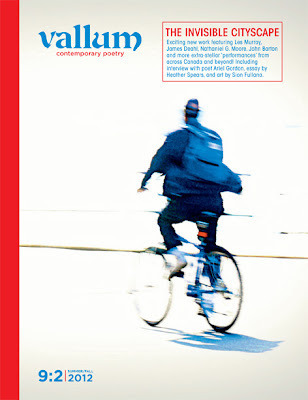 As you might have noticed, what with all my burbling of late about creative non-fiction, about writing on the intersection of the urban/nature writer and the naturalist, I've been trying to actively articulate my ideas about the invisible cityscape...
As you might have noticed, what with all my burbling of late about creative non-fiction, about writing on the intersection of the urban/nature writer and the naturalist, I've been trying to actively articulate my ideas about the invisible cityscape...
Where I fit in. Where nature fits in. Because more and more, I realize I am most comfortable in spaces that neither completely urban nor completely natural.
Winnipeg's elm canopy makes me intensely happy, right? But so does the Korean resto down the street.
Looking back, I've been writing poetry to the invisible city, specifically this faded grandiose city, for years.
First in my poetry/photography project with Jon Schledewitz on Winnipeg's derelict buildings, where we focused, literally and figuratively, on the softened edges of abandoned commercial and residential spaces.
But then later in Hump, where there's has a pile of what I called urban/nature/love poems, specifically poems set in Spence neighbourhood. A smaller clutch of poems were set in other Winnipeg parks / parking lots / brownfields. And my beloved forest, of course.
And my as-yet-untitled ms. will also likely contain a HEAP of urban/nature poems.
So it was a pleasure to cook up an interview on the subject with canny Winnipeg poet/publisher Sharon Caseburg.
My thanks to Sharon and to Vallum's editors for their work with me on this. I'm looking forward to having a good gnaw on the work in this issue!
Yay! Fun!
"VALLUM 9:2 - INVISIBLE 'CITYSCAPE' (HIDDEN URBAN LANDSCAPES)
The 'Cityscape' has fascinated people since the flâneurs of Paris and beyond. But what is unseen, underground or hidden eludes us. What are some of these hidden aspects of the 'cityscape,' the hidden urban landscape?"
 As you might have noticed, what with all my burbling of late about creative non-fiction, about writing on the intersection of the urban/nature writer and the naturalist, I've been trying to actively articulate my ideas about the invisible cityscape...
As you might have noticed, what with all my burbling of late about creative non-fiction, about writing on the intersection of the urban/nature writer and the naturalist, I've been trying to actively articulate my ideas about the invisible cityscape...Where I fit in. Where nature fits in. Because more and more, I realize I am most comfortable in spaces that neither completely urban nor completely natural.
Winnipeg's elm canopy makes me intensely happy, right? But so does the Korean resto down the street.
Looking back, I've been writing poetry to the invisible city, specifically this faded grandiose city, for years.
First in my poetry/photography project with Jon Schledewitz on Winnipeg's derelict buildings, where we focused, literally and figuratively, on the softened edges of abandoned commercial and residential spaces.
But then later in Hump, where there's has a pile of what I called urban/nature/love poems, specifically poems set in Spence neighbourhood. A smaller clutch of poems were set in other Winnipeg parks / parking lots / brownfields. And my beloved forest, of course.
And my as-yet-untitled ms. will also likely contain a HEAP of urban/nature poems.
So it was a pleasure to cook up an interview on the subject with canny Winnipeg poet/publisher Sharon Caseburg.
My thanks to Sharon and to Vallum's editors for their work with me on this. I'm looking forward to having a good gnaw on the work in this issue!
Yay! Fun!
Published on August 31, 2012 10:08
August 29, 2012
Foote note
Imagining Winnipeg LAUNCH
featuring Esyllt W. Jones
When: Wednesday September 26, 7:00 pm
Where: Atrium, McNally Robinson Grant Park (1120 Grant Avenue)
Cost: FREE
Please join University of Manitoba Press for the launch of Imagining Winnipeg: History through the Photographs of L.B. Foote.
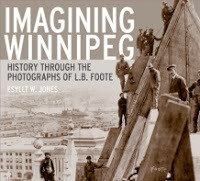 The launch will include light refreshments in addition to a slideshow of images from the book and a short talk by author Esyllt W. Jones.
The launch will include light refreshments in addition to a slideshow of images from the book and a short talk by author Esyllt W. Jones.
* * *
In an expanding and socially fractious early twentieth-century Winnipeg, Lewis Benjamin Foote (1873-1957) rose to become the city’s pre-eminent commercial photographer. Documenting everything from royal visits to deep poverty, from the building of the landmark Fort Garry Hotel to the turmoil of the 1919 General Strike, Foote’s photographs have come to be iconic representations of early Winnipeg life. They have been used to illustrate everything from academic histories to posters for rock concerts; they have influenced the work of visual artists, writers, and musicians; and they have represented Winnipeg to the world.
But in Imagining Winnipeg, historian Esyllt W. Jones takes us beyond the iconic to reveal the complex artist behind the lens and the conflicting ways in which his photographs have been used to give credence to diverse and sometimes irreconcilable views of Winnipeg’s past. Incorporating 150 stunning photographs from the more than 2,000 images in the Archives of Manitoba Foote Collection, Imagining Winnipeg challenges our understanding of visual history and the city we thought we knew.
Esyllt W. Jones is a history professor at University of Manitoba and is the author of the award-winning Influenza 1918: Death, Disease and Struggle in Winnipeg.
Born in Newfoundland, Lewis Benjamin Foote arrived in Winnipeg in 1902, where he bought a house on Gertrude Avenue and began a career as a professional photographer. For more than 50 years, Foote’s photographs chronicled the development of the city. He was an active photographer until 1947 and died ten years later.
* * *
Work started on this book just as I was hired at UMP, so I've been intimate with it for more than a year. My part of the project was putting together a blog entitled Lost Foote Photos and for coordinating the accompanying public call for Foote photos.
Later, I worked with UMP director David Carr on compiling new captions for the 150 images in the book. Which was basically research heaven for a girl interested in the history, the people and places, of Winnipeg.
I think the launch will be a humdinger. And there'll be wine! (That's what 'light refreshments' means in UMP-land...)
featuring Esyllt W. Jones
When: Wednesday September 26, 7:00 pm
Where: Atrium, McNally Robinson Grant Park (1120 Grant Avenue)
Cost: FREE
Please join University of Manitoba Press for the launch of Imagining Winnipeg: History through the Photographs of L.B. Foote.
 The launch will include light refreshments in addition to a slideshow of images from the book and a short talk by author Esyllt W. Jones.
The launch will include light refreshments in addition to a slideshow of images from the book and a short talk by author Esyllt W. Jones.* * *
In an expanding and socially fractious early twentieth-century Winnipeg, Lewis Benjamin Foote (1873-1957) rose to become the city’s pre-eminent commercial photographer. Documenting everything from royal visits to deep poverty, from the building of the landmark Fort Garry Hotel to the turmoil of the 1919 General Strike, Foote’s photographs have come to be iconic representations of early Winnipeg life. They have been used to illustrate everything from academic histories to posters for rock concerts; they have influenced the work of visual artists, writers, and musicians; and they have represented Winnipeg to the world.
But in Imagining Winnipeg, historian Esyllt W. Jones takes us beyond the iconic to reveal the complex artist behind the lens and the conflicting ways in which his photographs have been used to give credence to diverse and sometimes irreconcilable views of Winnipeg’s past. Incorporating 150 stunning photographs from the more than 2,000 images in the Archives of Manitoba Foote Collection, Imagining Winnipeg challenges our understanding of visual history and the city we thought we knew.
Esyllt W. Jones is a history professor at University of Manitoba and is the author of the award-winning Influenza 1918: Death, Disease and Struggle in Winnipeg.
Born in Newfoundland, Lewis Benjamin Foote arrived in Winnipeg in 1902, where he bought a house on Gertrude Avenue and began a career as a professional photographer. For more than 50 years, Foote’s photographs chronicled the development of the city. He was an active photographer until 1947 and died ten years later.
* * *
Work started on this book just as I was hired at UMP, so I've been intimate with it for more than a year. My part of the project was putting together a blog entitled Lost Foote Photos and for coordinating the accompanying public call for Foote photos.
Later, I worked with UMP director David Carr on compiling new captions for the 150 images in the book. Which was basically research heaven for a girl interested in the history, the people and places, of Winnipeg.
I think the launch will be a humdinger. And there'll be wine! (That's what 'light refreshments' means in UMP-land...)
Published on August 29, 2012 08:53
August 25, 2012
SPORED: Eden Robinson

* * *
From Eden Robinson's The Sasquatch at Home (University of Alberta Press, 2011).
* * *
I've had a thing for Eden Robinson's writing ever since I read her Monkey Beach back in 2002 or 3. It was dark Aboriginal fantasy, and like nothing I'd ever read. Similar to Neil Gaiman, that I was also reading at the time, but Canadian and somehow completely fresh (and bleak and sad) compared to Gaiman's retelling of European myths.
In late 2005, I managed to snag her third book, Blood Sports, from the Winnipeg Free Press' pile of review copies. It was dark, again, but completely different from Monkey Beach...
I've been waiting for another Robinson novel for a few years now, but when I saw that U of A Press had published her Henry Kreisel Lecture, The Sasquatch at Home: Traditional Protocols and Modern Storytelling, I had to have it.
At 50 pages, it's a slim volume. But it has french flaps. And the most awesome cover image ever. The Sasquatch at Home indeed!
So while I usually spore poems, and poems by people I know, I made an exception for this text. Because it's knocking around my head. And because I saw three magnificent boulevard mushrooms one day when I was walking to pick up the girl from daycare.
(I also spored for a few other texts, which I'll post in the coming weeks...)
Published on August 25, 2012 21:13
August 24, 2012
Press check!
So I got to go on a press check on Thursday for UMP's Imagining Winnipeg book (which I still refer to as 'the Foote book' in my head...).
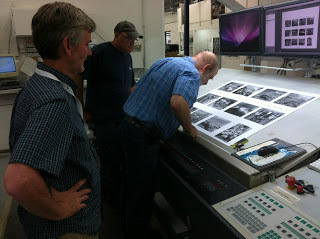 l-r: David Carr, Randy the pressman, and Steven Rosenberg.After a twelve-hour day, driving to and from Altona, where the Friesens plant is, my camera is full of pictures of UMP director David Carr and Doowah Design's Steven Rosenberg.
l-r: David Carr, Randy the pressman, and Steven Rosenberg.After a twelve-hour day, driving to and from Altona, where the Friesens plant is, my camera is full of pictures of UMP director David Carr and Doowah Design's Steven Rosenberg.
My clothes still have that 'new book smell.'
But more than that, my head is still full of the enormity of the place. Reams and stacks of paper...
What look like water pipes, coming down from the ceiling, specifically for ink to feed the presses...
The ancient embosser in the middle of all the machinery, including a robot arm that lifts boxes...
The immense art book that retails for $5,000 in Friesens trophy room...
And yet, homemade cherry pie in the cafeteria where we waited the 45 minutes or so between signatures. And the Safeway bag on a cafeteria table full of extra cucumbers. And the quilted version of the cover of Robert Munsch's Love You Forever on the wall.
Thanks to Glenda for showing us around, for making sure we had covers and one of each of the signatures we approved to take home and for directing us to Jasmine's Tea Room, just down the street from Friesens.
Also, yay for my first press check!
 l-r: David Carr, Randy the pressman, and Steven Rosenberg.After a twelve-hour day, driving to and from Altona, where the Friesens plant is, my camera is full of pictures of UMP director David Carr and Doowah Design's Steven Rosenberg.
l-r: David Carr, Randy the pressman, and Steven Rosenberg.After a twelve-hour day, driving to and from Altona, where the Friesens plant is, my camera is full of pictures of UMP director David Carr and Doowah Design's Steven Rosenberg.My clothes still have that 'new book smell.'
But more than that, my head is still full of the enormity of the place. Reams and stacks of paper...
What look like water pipes, coming down from the ceiling, specifically for ink to feed the presses...
The ancient embosser in the middle of all the machinery, including a robot arm that lifts boxes...
The immense art book that retails for $5,000 in Friesens trophy room...
And yet, homemade cherry pie in the cafeteria where we waited the 45 minutes or so between signatures. And the Safeway bag on a cafeteria table full of extra cucumbers. And the quilted version of the cover of Robert Munsch's Love You Forever on the wall.
Thanks to Glenda for showing us around, for making sure we had covers and one of each of the signatures we approved to take home and for directing us to Jasmine's Tea Room, just down the street from Friesens.
Also, yay for my first press check!
Published on August 24, 2012 22:37
August 23, 2012
first lines
So Darryl Joel Berger, the writer/visual artist from Kingston I'm collaborating with, just sent me this image.
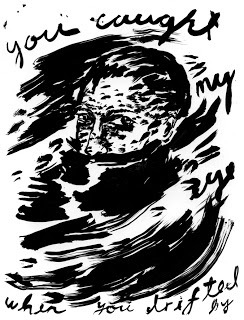
It's based on a poem I wrote to his image of a heavily-veiled woman in Victorian dress. Which was based on a poem I wrote to his image of a boy with bandaged eyes.
Which was based on my poem I wrote to his image of a jaundiced boy in a sailor suit, smoking a corn cob pipe.
Yah. Like that.
And while I haven't had the chance to be stuck on it yet, I thought I'd see what youse could come up with...
...which is to say, I'm accepting first lines for my poem on this image.
...in the comments section of this post.
(GO!)

It's based on a poem I wrote to his image of a heavily-veiled woman in Victorian dress. Which was based on a poem I wrote to his image of a boy with bandaged eyes.
Which was based on my poem I wrote to his image of a jaundiced boy in a sailor suit, smoking a corn cob pipe.
Yah. Like that.
And while I haven't had the chance to be stuck on it yet, I thought I'd see what youse could come up with...
...which is to say, I'm accepting first lines for my poem on this image.
...in the comments section of this post.
(GO!)
Published on August 23, 2012 18:11



